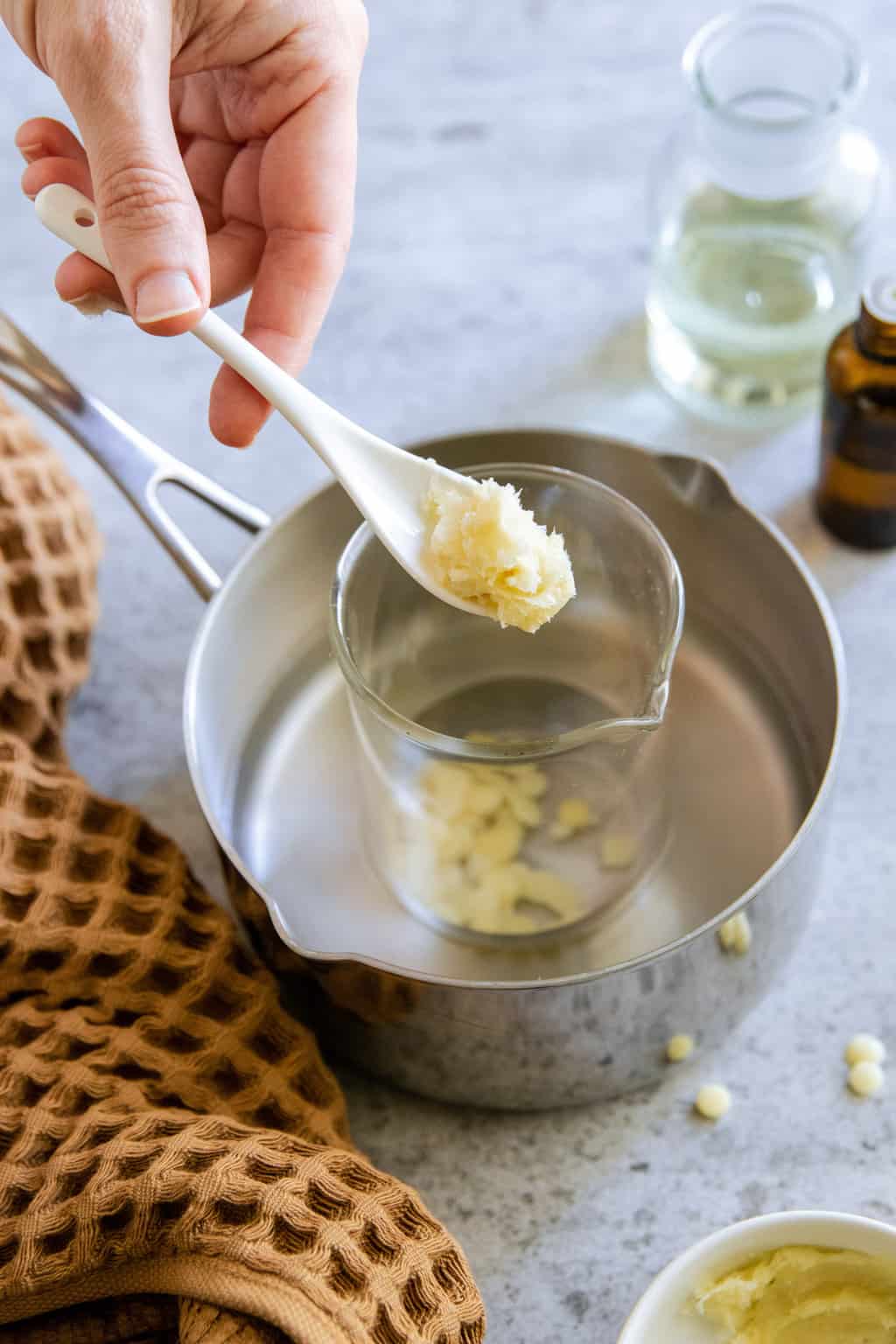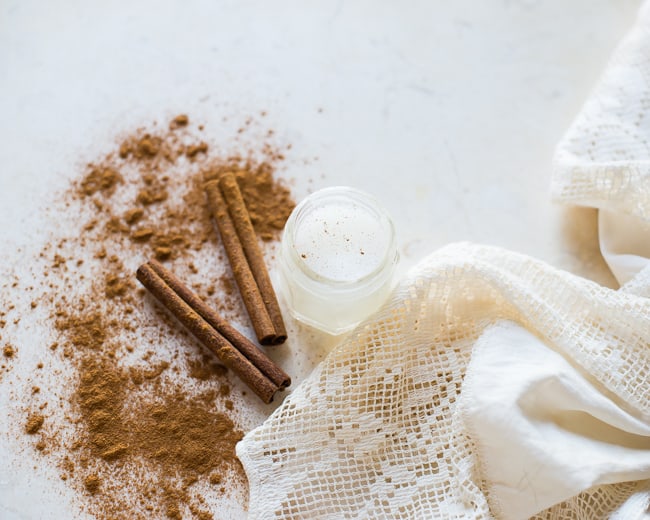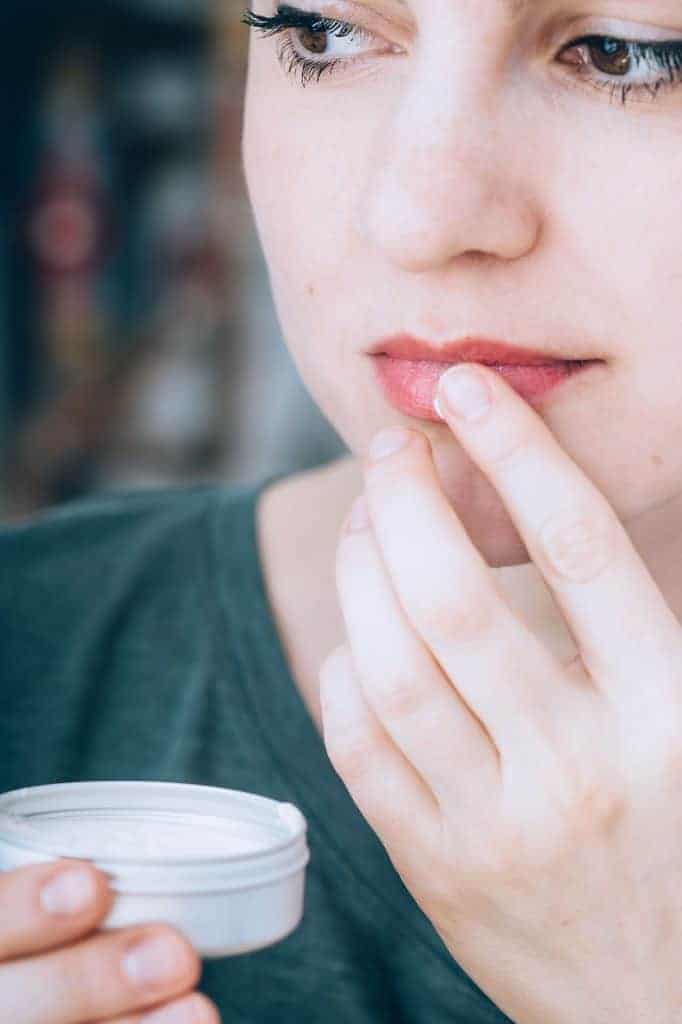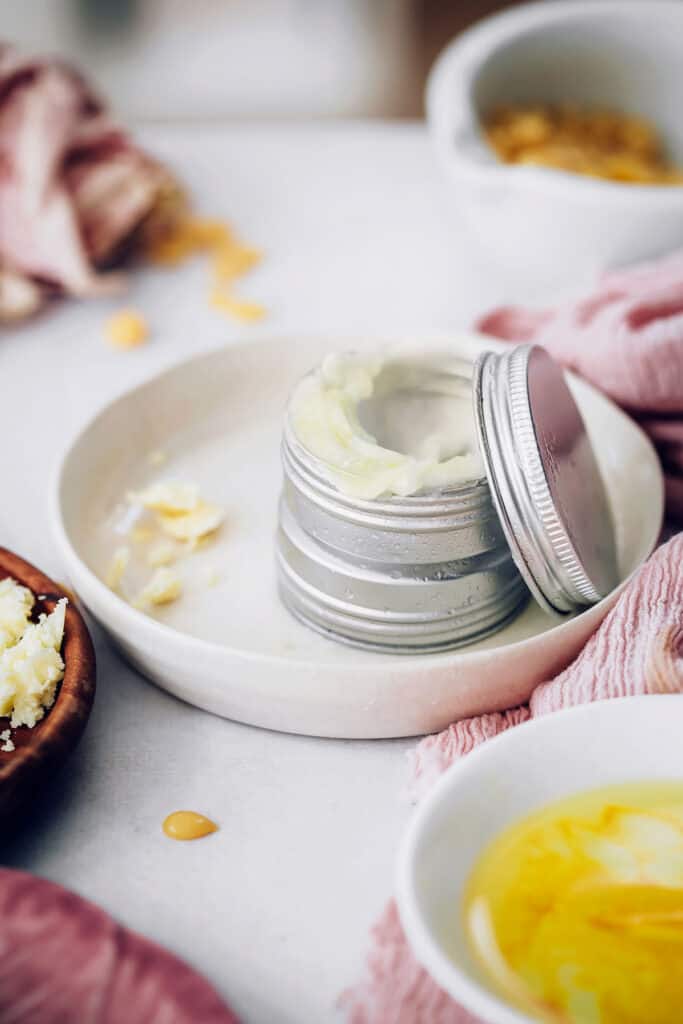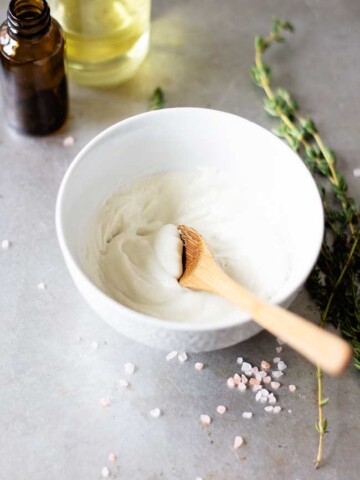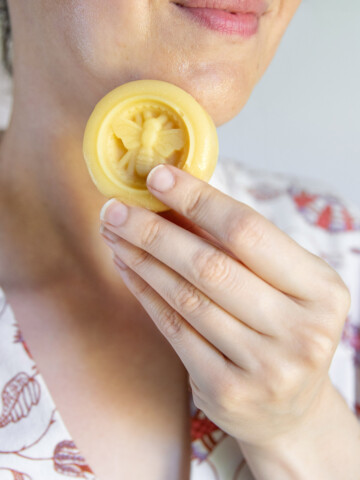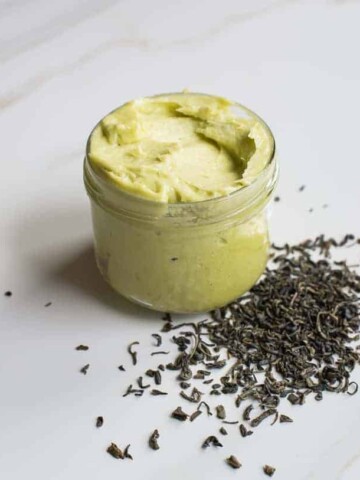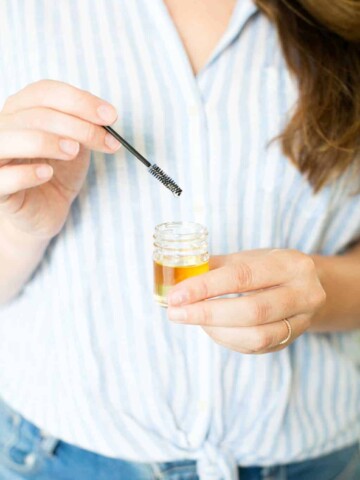Whenever someone asks what’s the one thing I never leave the house without, I always reply, lip balm! Of course, once in a while I forget it at home and those are the worst days—especially in winter.
But you know what helps jog my memory? If I really love my lip balm of the moment, I try to make enough so there’s one in every pocket and inside every bag, but sometimes I still forget!
I’ve found that making the perfect lip balm comes down to the right ratio of wax to oil. Wax gives it a solid consistency that sticks to lips and won’t just melt off. And oil makes lip balm hydrating and nourishing, so it can soothe a parched pout. With those two ingredients locked in, you can then customize your lip balm with nourishing essential oils, colors, or flavors to meet your needs.
How to Make Lip Balm—the Complete Guide
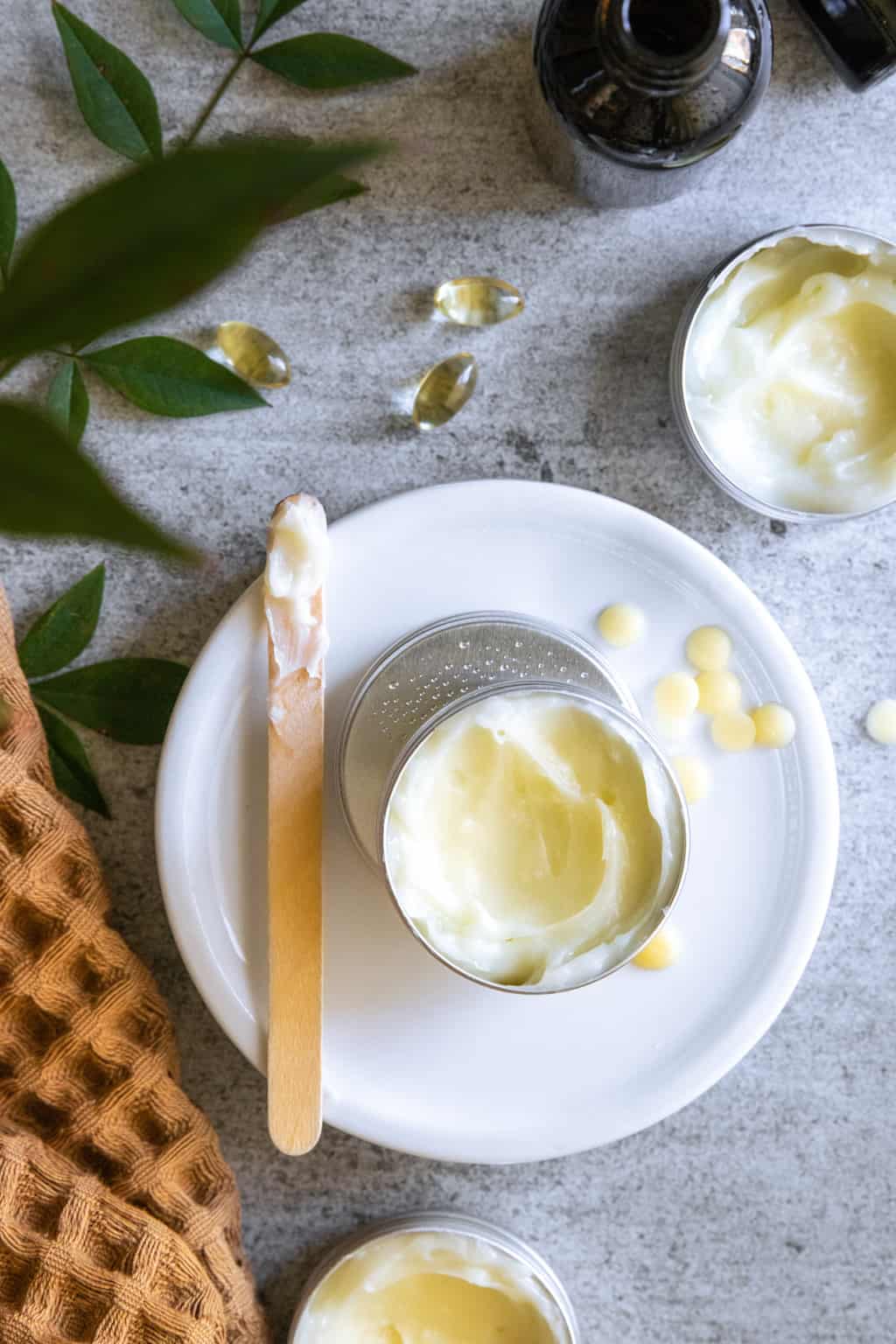
What ingredients do I need?
All natural lip balms start with two basic ingredients: wax and oil. While we recommend only a few options for wax, there are many, many options you can use for oils.
I would start by focusing on finding your ideal consistency first, using a combination of wax, oil, and soft butters. Then you can add optional ingredients such as honey, colorants, or flavorings.
Wax options for lip balms
Wax is vital for giving lip balm its shape. Without it, your lip balm would be too creamy to coat the lips and sink in.
- Beeswax – Most natural lip balms contain beeswax because it’s incredibly nourishing, protects lips, and helps replenish moisture. It’s also a strong wax with a high melting point, so you only need a little bit to reach the perfect lip balm consistency. I recommend using beeswax pastilles rather than solid beeswax blocks because they’re easier to work with.
- Candelilla wax – A great vegan alternative to beeswax, candelilla wax is obtained from the leaves of the Candelilla shrub, which is native to Mexico and the Southwest United States. It’s often used in lotions, lip balms, and other oil-based beauty products.
- Carnauba wax – Similar to candelilla, carnauba wax is another vegan option obtained from the leaves of palm trees. It’s a very hard wax with a high melting point and an almost powdery appearance, which may take a while to get used to at first. But because it’s so hard, a little goes a very long way.
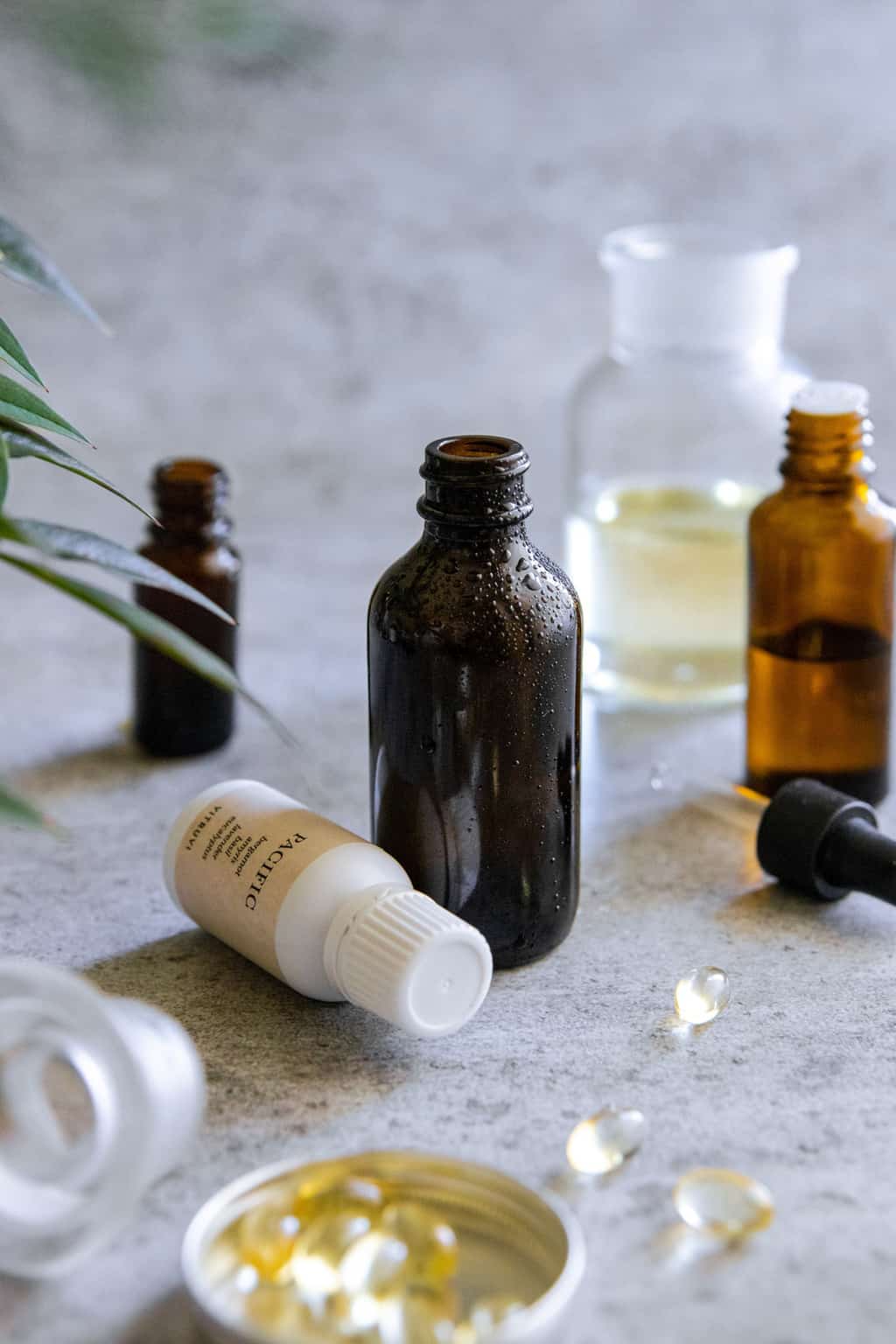
Soft butter options for lip balms
Soft butters, sometimes called body butters, have emollient properties and help give your lip balm a creamy consistency. Some of my favorite butters include:
- Shea butter – High in vitamins A, E, and F and a variety of antioxidants, shea butter has potent anti-inflammatory and antioxidant properties [source].
- Cocoa butter – Cocoa butter is one of the most popular body butters on the market, thanks to its skin-soothing antioxidants, hydrating properties, and heavenly scent.
- Kokum butter – Kokum butter is a powerful moisturizer that’s often used to nourish dry skin, hair, and scalp. It’s harder to find than shea and cocoa butters, but I’ve had good luck sourcing kokum butter from online retailers like Amazon.
- Mango butter – Much like the others, mango butter is a highly effective moisturizer. Thanks to vitamins E and C, it may help protect skin from sun damage and environmental stressors. You can find it easily online or in local specialty shops and health food stores.
Carrier oil options for lip balm
You can use almost any food grade carrier oil you like for homemade lip balm, but these are a few of our favorites:
- Hemp seed – Rich in essential fatty acids, hemp seed oil gently conditions skin and leaves lips feeling soft, smooth, and nourished.
- Sweet almond – Thanks to its emollient properties, almond oil has been used for centuries to soothe dry skin. Chock full of healthy fats, almond oil’s emollient properties replenish moisture [source] and lock it in so your lips remain plump and flake-free.
- Olive – Olive oil contains a plethora of antioxidants, such as flavonoids, phenolic acids, tannins, and stilbenes, which have antioxidant, anti-inflammatory, and wound healing properties. It’s also shelf stable, and unless exposed to heat, it won’t go rancid quickly, helping to extend the shelf life of your lip balm.
- Coconut – Known to help repair the skin barrier, coconut oil encourages wound healing and decreases the appearance of aging. It’s also solid at room temperature, so it can help your lip balm hold its shape without requiring much extra wax.
- Grapeseed – Thanks to its phenolic compounds, resveratrol, and vitamin E, grapeseed oil has potent antioxidant properties, which are very healing and helpful for soothing inflammation.
- Camellia – Camellia oil has been proven to reduce the signs of aging and increase collagen production [source], making lips look fuller.
- Carrot seed – The antioxidant properties of carrot seed oil help soothe skin irritation and protect against sun-induced free radical damage [source].
- Rosehip seed oil – Scientific studies suggest that rosehip seed oil may help improve scarring [source], thanks to its antioxidant, anti-inflammatory, and antiaging properties.
Other carrier oils you can use:
Optional ingredients
- Vegetable glycerin – Glycerin, a lightweight emollient, is commonly found in skincare products because it helps heal dry, chapped skin. Applying glycerin regularly can help stimulate cell turnover and improve the condition of lips [source].
- Honey – We’re huge fans of using honey in skincare routines. It contains amino acids, vitamins, enzymes, and minerals that soothe skin, regulate pH, aid wound healing, and keep skin looking youthful [source].
- Vitamin E oil – Vitamin E oil keeps skin looking young and radiant [source].
- Essential oils – Soothing and softening essential oils, like chamomile, lemon balm, lavender, frankincense, turmeric, and rose absolute, make healing additions to homemade lip balm.
What container should I use?
You don’t have to get too fancy with your lip balm containers. The easiest thing to do is simply save old lip tins, plastic lip balm containers, glass condiment jars, and any other pocket-sized containers you can find around the house and refill them.
But if you’re looking to make lots of lip balm and want more traditional containers, here are a few options:
- Cardboard lip balm tubes – These ecofriendly push-up tubes give your lip balm a green makeover. They come in a variety of sizes, depending on your needs. And when you’re done, they can be reused, recycled, or composted.
- Aluminum tins – Aluminum cosmetic tins are the perfect size for homemade lip balm, serum, makeup, or whatever else you may whip up. They also make a gorgeous finished product in case you plan to gift or sell them later.
- Small glass jars – I love using small glass pots for my lip balm. These miniature glass jars with aluminum lids are perfect for those of us who tend to blow through smaller quantities quickly. When you’re done, clean them out and refill them, or use ’em to hold herbs and spices, paper clips, or other small knick-knacks.
- Plastic lip balm tubes – You can always buy traditional lip balm tubes in bulk from places like Amazon. Just be forewarned, these plastic tubes aren’t recyclable, so you may want to think twice before buying them in large quantities, and instead, look for repurposed or recyclable options. You can also clean them out and refill them to cut down on waste.
So how do I make homemade lip balm?
This recipe is perfect for getting your feet wet with the process of making homemade lip balm. It makes about 1 ounce of lip balm, so feel free to scale it up if you want to make more or keep the measurements as-is to test things out.
Basic 3-Ingredient Lip Balm Recipe
—1 tablespoon shea butter
—1 teaspoon organic beeswax
—2 teaspoons sweet almond oil (or any oil of your choosing—see the list above)
—Measuring cup and small saucepan (or a double boiler)
—Lip balm containers
Step 1 | Melt wax and butter
Combine shea butter and beeswax in a heat-proof measuring cup. Place the measuring cup inside a small saucepan, and add enough water to reach halfway up the side of the measuring cup. Heat on low until melted.
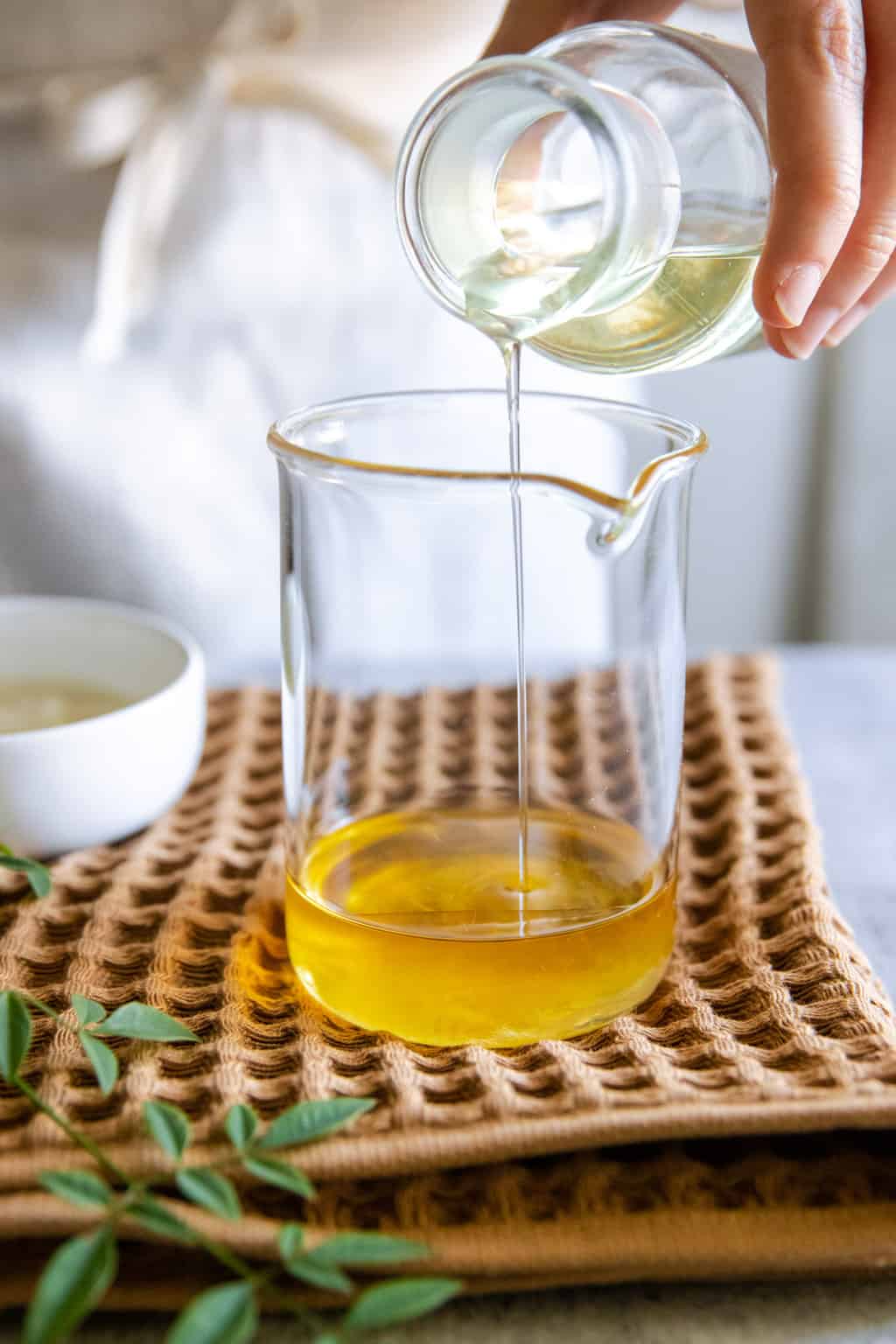
Step 2 | Add carrier oil
Remove from the heat and add the remaining oil, stirring well.
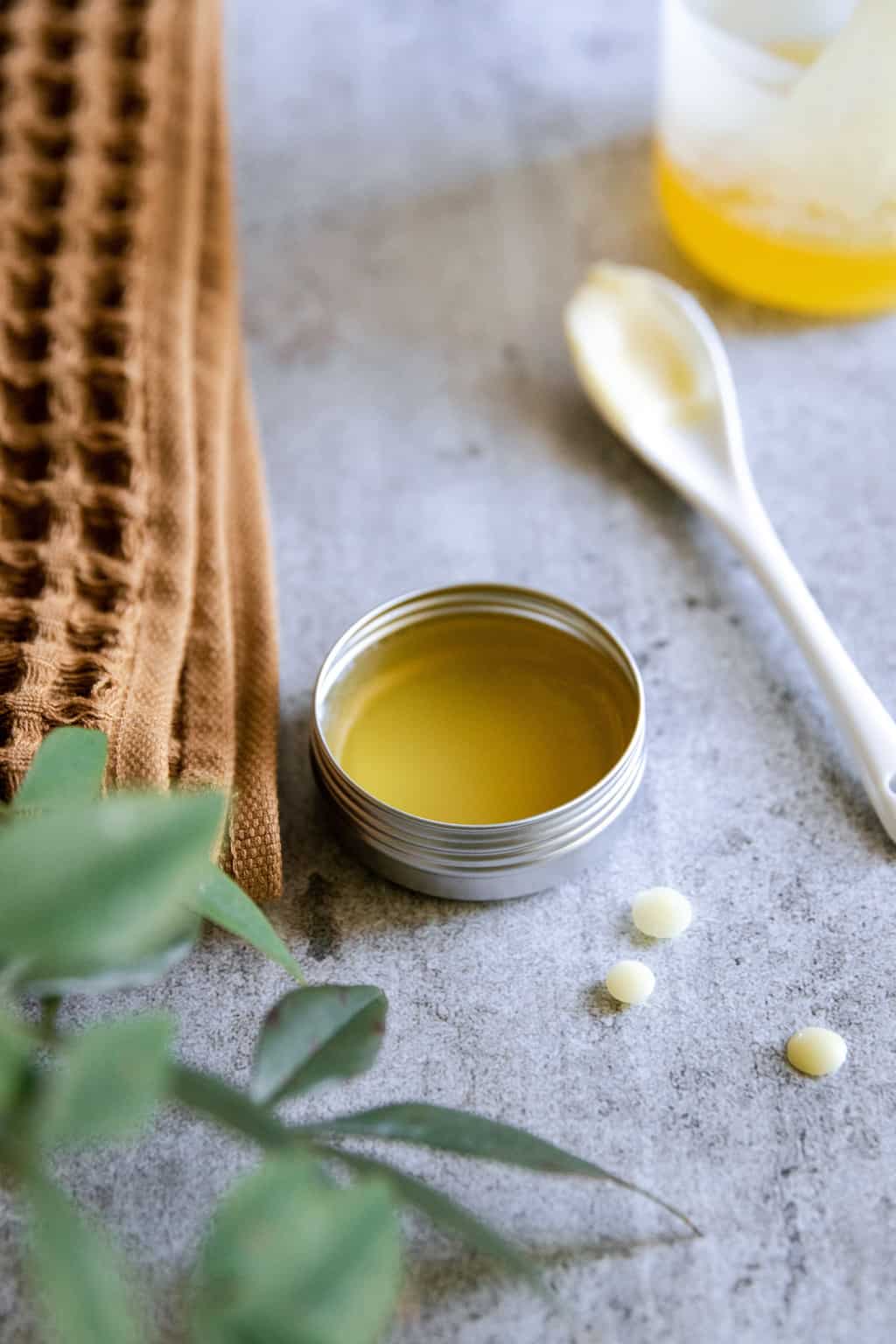
Step 3 | Pour and cool
Pour the mixture into your lip balm containers and let cool completely.
What if I’m vegan and don’t want to use beeswax?
If you’re vegan or just don’t like the texture of beeswax, here’s how to leave it out.
Lip Balm without Beeswax
—1–½ teaspoons carnauba wax
—1 teaspoon cocoa butter
—1 teaspoon shea butter
—2 teaspoons jojoba oil
—1 teaspoon vegetable glycerin
—Measuring cup and small saucepan (or a double boiler)
—Lip balm containers
Combine carnauba wax, cocoa butter, and shea butter in a heat-proof measuring cup. Place the measuring cup inside a small saucepan, and add enough water to reach halfway up the side of the measuring cup.
Heat the ingredients on low until melted.
Remove from the heat and let cool for several minutes before adding the jojoba oil and glycerin, stirring well.
Pour the mixture into your lip balm containers and let cool completely.
How do I add honey?
Honey is amazing for your skin and your lips—it’s a natural antibacterial and speeds up wound healing [source], so your lips will stop being chapped in no time!
Healing Lip Balm with Honey
—2 teaspoons beeswax (feel free to use carnauba wax if vegan)
—2 teaspoons cocoa butter
—1 teaspoon shea butter
—2 teaspoons almond oil
—2–3 vitamin E capsules
—2 teaspoons raw honey
Combine beeswax, cocoa butter, and shea butter in a heat-proof measuring cup. Place the measuring cup inside a small saucepan, and add enough water to reach halfway up the side of the measuring cup.
Heat the ingredients on low until melted.
Remove from the heat and add the jojoba oil and glycerin, stirring well.
Let the oil mixture cool for about 5–10 minutes, stirring often. Once it has cooled and thickened considerably but isn’t yet hard, add the honey and stir well.
Scoop the mixture into your lip balm containers and smooth with the back of a spoon. Place in the freezer for several minutes to cool completely.
Tips for working with honey:
Honey, which is water-based, tends to settle at the bottom of the container when used in homemade bath and body products. There are two ways around this:
First method: Before adding your honey, let the melted oil mixture cool to almost room temperature—you should see it starting to form a film on top, and it should be rather thick when stirred. Then place it in the freezer for a few minutes to finish cooling.
The cooler the oils are when you add the honey, the less separation you’ll see. And by rapidly cooling the mixture after you’ve added the honey, you’ll prevent further separation.
Second method: Use an emulsifying wax to bind the honey and oil-based ingredients and keep them from separating. Follow the instructions on the package to figure out how much emulsifying wax you need for the recipe.
How do I add SPF?
While we are all about using SPF on our bodies to protect our skin from the sun, what about our lips? They’re just as vulnerable as the rest of our skin but can get overlooked—you need an SPF lip balm! Protect your pout with natural SPF protection from zinc oxide and green tea-infused coconut oil.
Lip Balm with SPF
—1 teaspoon beeswax
—1 tablespoon olive oil
—1 teaspoon cocoa butter
—2 teaspoons zinc oxide powder
Combine the cocoa butter and beeswax in a double boiler over medium heat, and heat the mixture until the beeswax has melted.
Remove from the heat and stir in olive oil and 2 teaspoons of zinc oxide powder.
Mix well. Then transfer to lip balm containers and let cool completely.
How do I add essential oils?
Essential oils are a wonderful addition to homemade lip balm—thanks to their healing and regenerative properties. You can add essential oils to any of the recipes above by following these directions:
Step 1: Melt your wax, carrier oil, and body butters in a double boiler.
Step 2: Remove the oil mixture from the heat and let cool for about 5 minutes. Since essential oils are volatile, you’ll want to wait until the melted lip balm mixture has cooled considerably before adding them.
Step 3: Add a maximum of 6 drops of essential oil per 2 ounces of carrier oil to create a safe dilution for your balm. Stir well.
Step 4: Pour the mixture into your lip containers and let cool completely.
Here are some of the best essential oils for lip balm:
- Geranium – This is the EO to soothe dry, cracked skin. It has antimicrobial and anti-inflammatory properties [source]. Plus, it smells like a dream.
- Chamomile – Chamomile EO has long been used for chapped skin and to replenish moisture [source].
- Lavender – Lavender essential oil has been shown to improve wound healing and boost collagen production [source].
How do I add flavor?
If you’d like your lip balm to have flavor, there are two ways to go about it:
Herbs and spices – Adding spices such as cinnamon, rose petals, coffee, or finely ground dried citrus peels is a great way to get a little flavor without the chemicals.
You may find that powdered herbs tend to sink to the bottom of your lip balm or give it a grainy texture. So, I recommend experimenting with different herbs before making a large batch.
Flavor oils – Most flavored cosmetics contain what’s called “flavor oils” to get their taste. You can find common flavors such as peppermint, lemon, and vanilla online or at your local craft store. Just be forewarned, commercial flavor oils aren’t considered nontoxic like natural spices are.
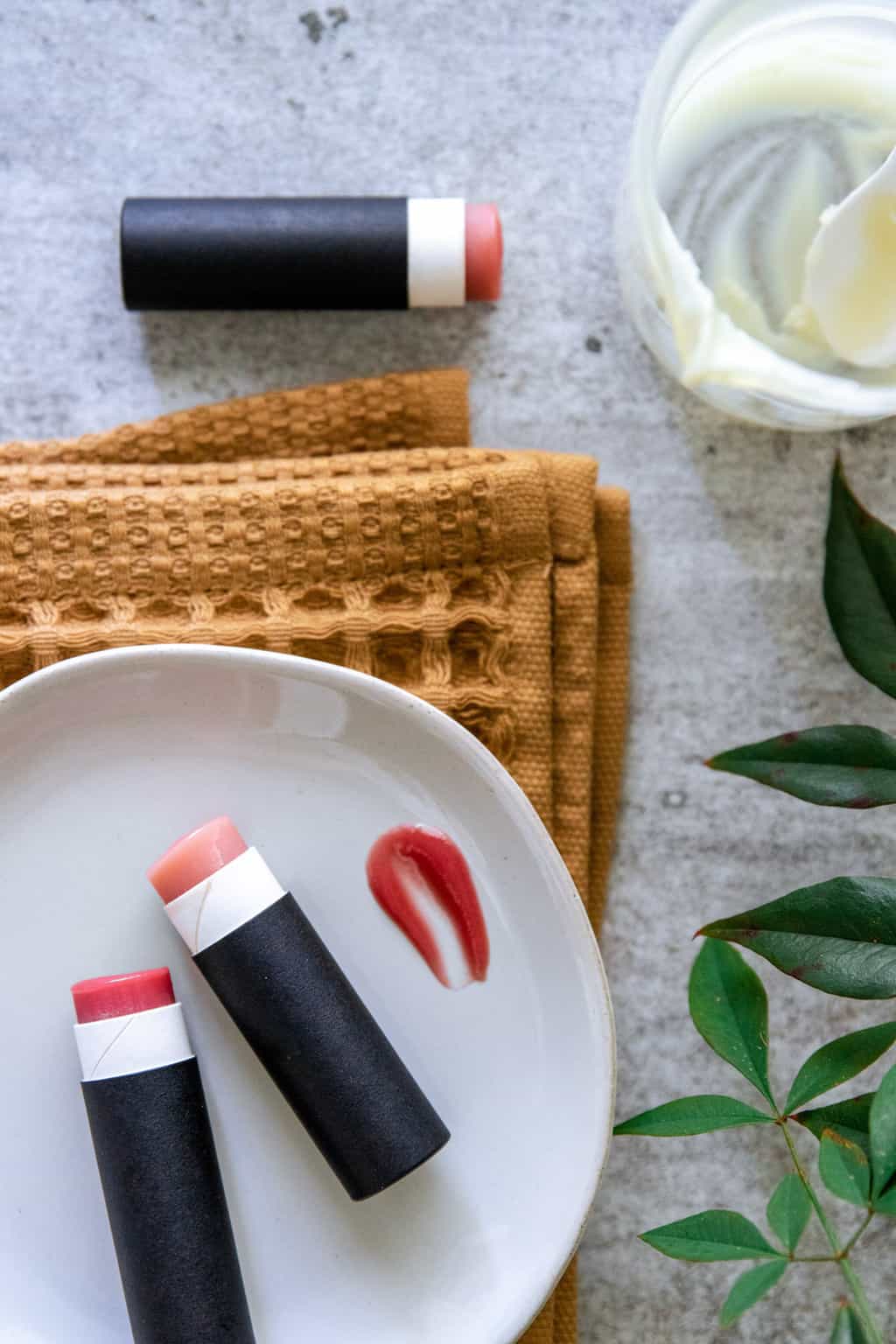
How do I add color?
As much as I love a classic red lip, sometimes you want something that’s a barely-there wash of color. A tinted lip balm is just enough to make your lips festive for a special occasion while still moisturizing and healing!
Since lip balm is oil based, an oil-based colorant is the easiest way to add a pinch of color. I recommend cutting off a sliver of your favorite natural lipstick and adding it to your DIY lip balm while the wax is still hot.
Stir well to melt and disperse the pigment. Then pour the mixture into your lip balm containers, and let them cool.
If you don’t want to cannibalize your favorite lipstick, you can always add a pinch of dried raspberry or beet root powder to the melted balm to give it a pink tint. Just note that, like honey, powdered pigments tend to sink to the bottom of the tin.
To prevent this, let your oils cool until they’re the consistency of a thick serum before adding the powder. Stir well, then spoon the mixture into your containers, and let them cool completely.
Read next: 17 DIY Lip Scrubs for a Super-Smooth Pout
Ready to DIY? 7 Homemade Lip Balm Recipes
These easy lip balm recipes will help keep your lips soft and moisturized!
1. Lip-Plumping Homemade Lip Balm
Cinnamon will plump your lips, while coconut oil and vitamin E will keep them moisturized and healthy. It’s the perfect lip balm to prep your lips for makeup—they’ll be a little fuller but super hydrated, making any lipstick color look extra amazing!
Use right after a lip scrub for a perfectly kissable, plump pout.
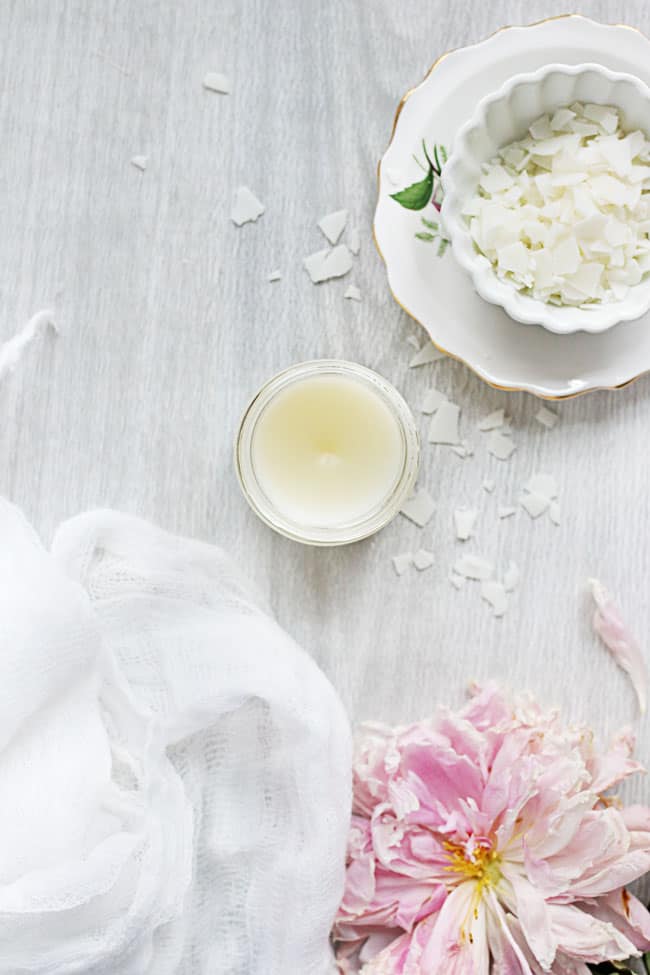
2. Vegan Lip Balm with Lavender
Vegan lip balm can be hard to find, but it’s super easy to make your own! By combining a plant-based wax with a solid oil like coconut oil, you can effectively replace the beeswax altogether and still end up with a nourishing lip balm.
3. Raspberry Tinted Lip Balm
As much as I love a classic red lip, sometimes you want something that’s just a barely-there wash of color. This is tinted just enough to make your lips festive for a special occasion but still moisturizing!
It’s also a great gift for tweens that are just starting to get into makeup—its color is not too strong for them, but it’s still enough to look a little different (and much like makeup).
4. Green Tea SPF Lip Balm
Protect your pout with natural SPF protection from zinc oxide and green tea-infused coconut oil. Green tea’s powerful antioxidants help to heal sun damage and slow the aging process.
5. All-N-One DIY Body Balm
This does-it-all body balm contains three of our favorite moisturizers: coconut oil, jojoba oil, and cocoa butter. All three work together to enrich and soften dry skin.
You can use this balm anywhere—hands, feet, hair, elbows, and lips. Put a tiny bit on your fingertips to tame flyaway hairs, and then also apply to chapped lips.
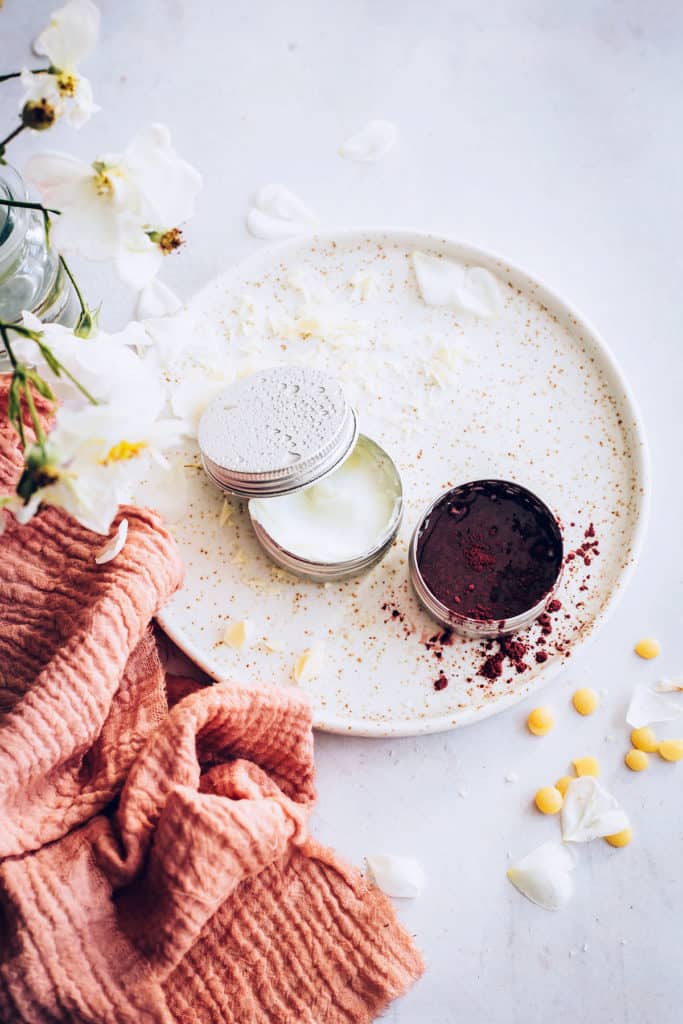
6. Homemade Honey Lip Balm
This recreation of Lush’s honey lip balm is packed with moisture from shea butter, honey, almond oil, and olive oil. Honey is amazing for your skin and your lips—it’s a natural antibacterial and speeds up wound healing [source], so your lips will stop being chapped in no time!
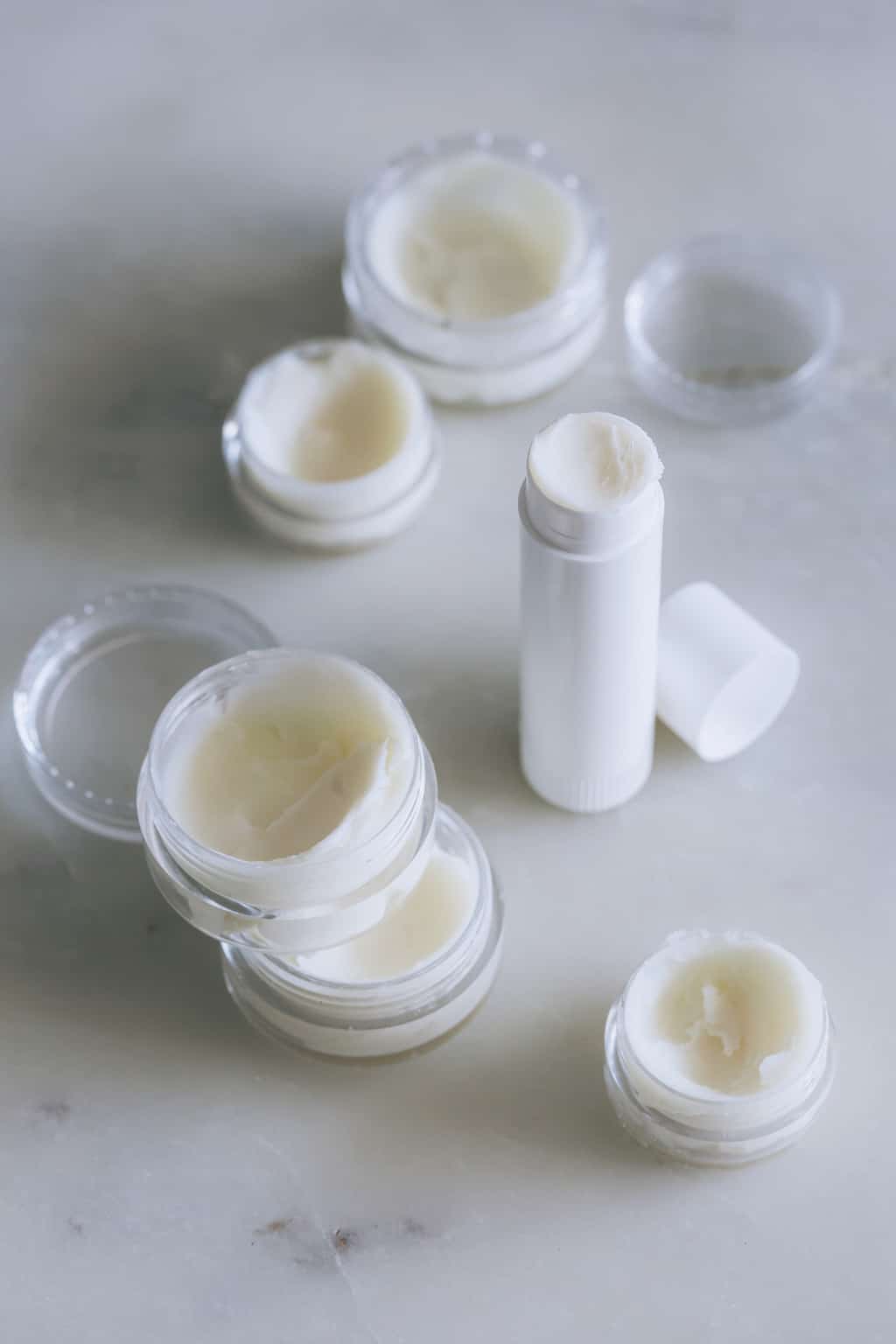
7. No More Cold Sores Lip Balm
This recipe is not only moisturizing for chapped lips, but it also includes essential oils that help to keep cold sores at bay.
References
Click to see references
1. Ahmad Z. The uses and properties of almond oil. Complement Ther Clin Pract. 2010.
2. Binic I, et al. Skin ageing: natural weapons and strategies. Evid Based Complement Alternat Med. 2013.
3. Singh S, et al. Formulation and evaluation of carrot seed oil-based cosmetic emulsions. J Cosmet Laser Ther. 2019.
4. Valerón-Almazán P, et al. Evolution of post-surgical scars treated with pure rosehip seed oil. J Cosmet. Dermatol Sci. 2015.
5. Lin TK, et al. Anti-inflammatory and skin barrier repair effects of topical application of some plant oils. Int J Mol Sci. 2018.
6. Fluhr JW, et al. Glycerol and the skin: holistic approach to its origin and functions. Br J Dermatol. 2008.
7. Yaghoobi R, et al. Evidence for clinical use of honey in wound healing as an anti-bacterial, anti-inflammatory anti-oxidant and anti-viral agent: a review. Jundishapur J Nat Pharm Prod. 2013.
8. Keen MA, et al. Vitamin E in dermatology. Indian Dermatol Online J. 2016.
9. Ahmed S, et al. Honey as a potential antioxidant medicine: an insight into its molecular mechanisms of action. Oxid Med Cell Longev. 2018.
10. Narnoliya LK, et al. The phytochemical composition, biological effects and biotechnological approaches to the production of high-value essential oil from geranium. Essential Oil Research. 2019.
11. Lee SH, et al. Effect of German chamomile oil application on alleviating atopic dermatitis-like immune alterations in mice. J Vet Sci. 2010.
12. Samuelson R, et al. The effects of lavender essential oil on wound healing: a review of the current evidence. J Altern Complement Med. 2020.

